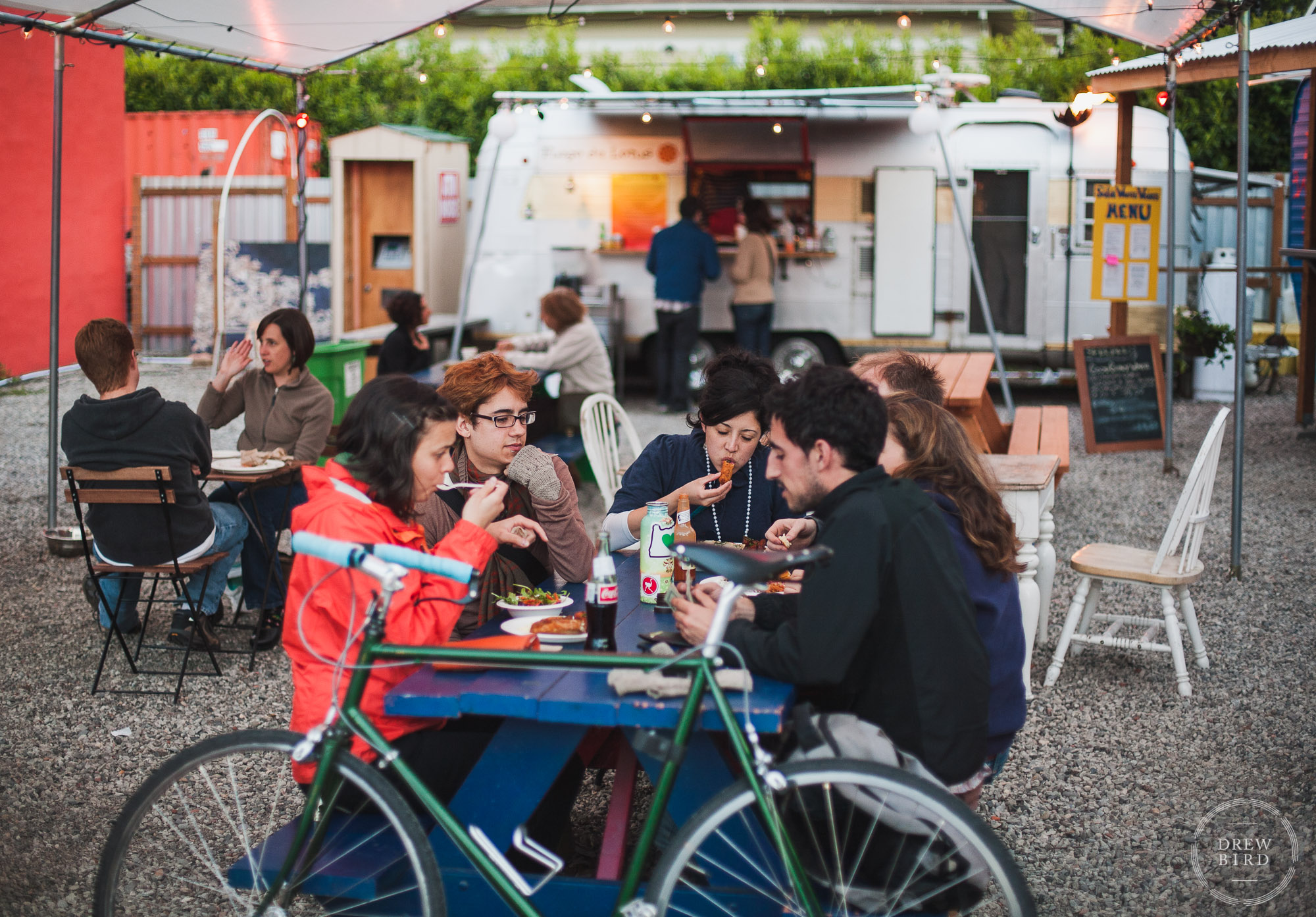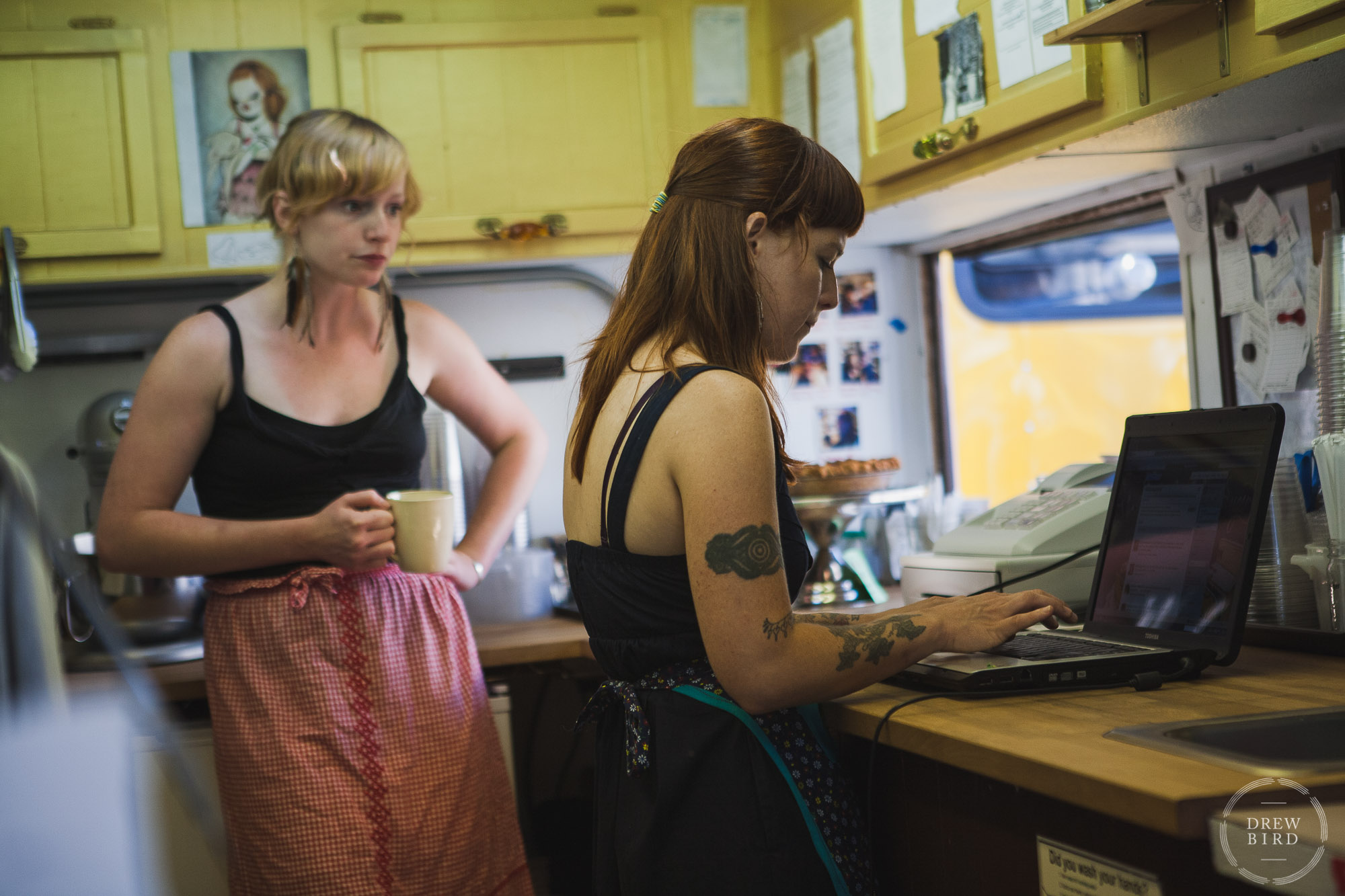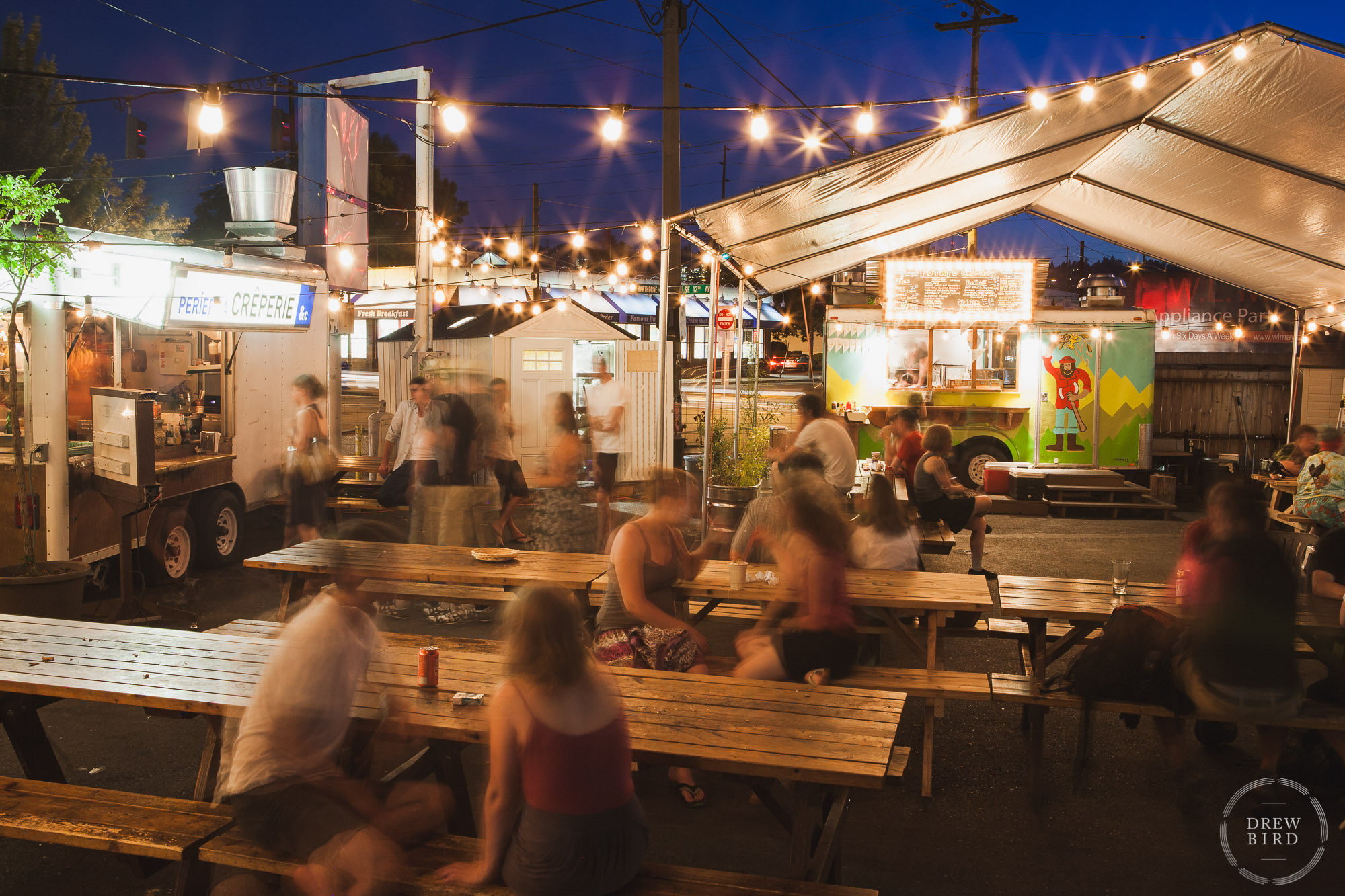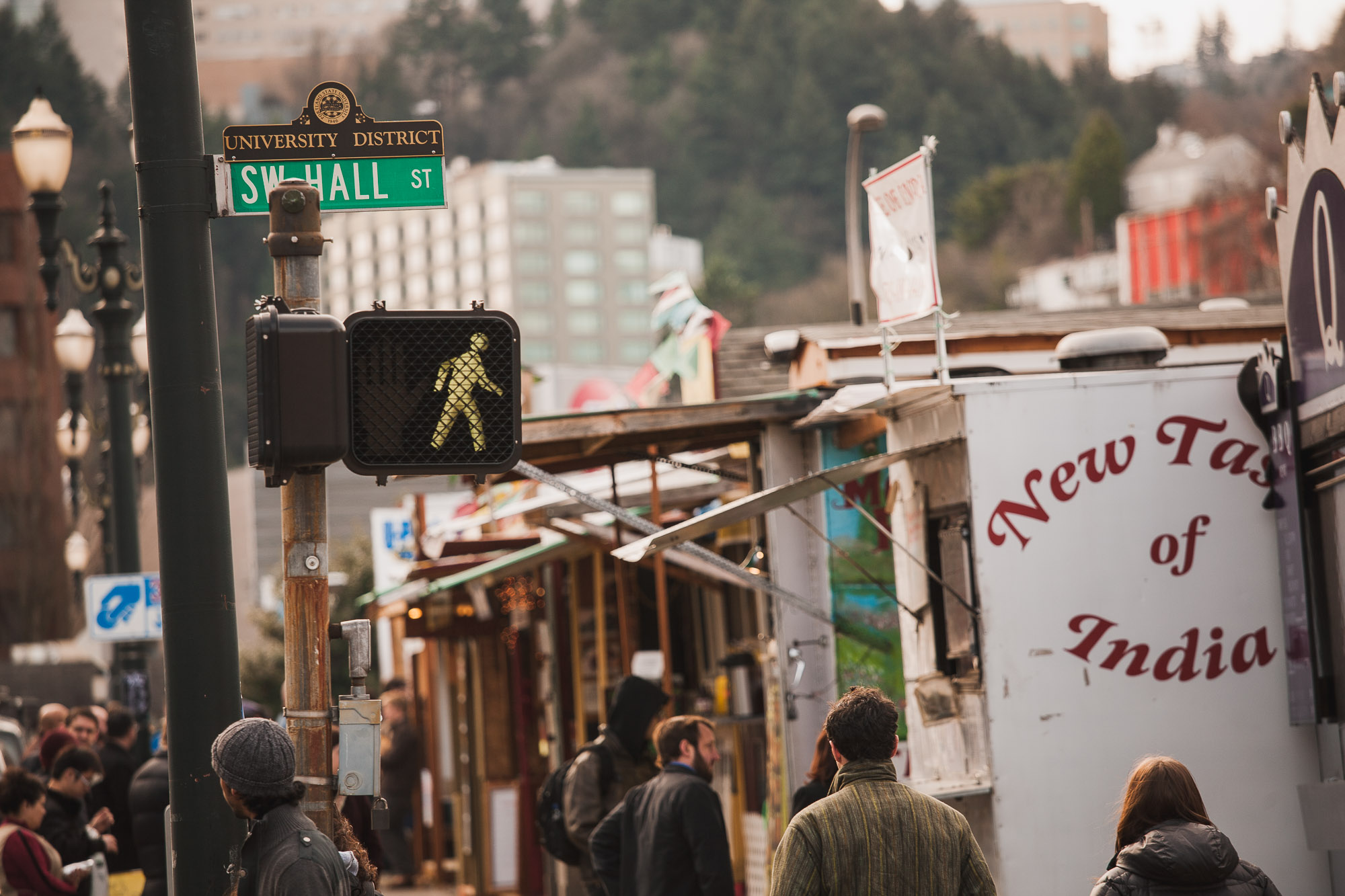The Phenomena
During the mid-noughties Portlanders began birthing new food carts at ludicrous speed. Between 2005 and 2009 the number of carts registered for business in Stumptown more than doubled to over 600. Most carts could be found in mini-clusters called pods that filled the periphery of surface level parking areas. Like some fabulous form of alchemy, parking areas and vacant lots seemed magically to transform from derelict eyesores on the urban landscape to vibrant centers of food, music, and community. Food carts were the catalyst for this metamorphosis.
What factors contributed to Portland’s street food renaissance? And what was the scene like during this golden era? Who were the people starting businesses as food cart owners? What were their stories? And how did the emergence of food cart pods influence Portland’s community life? This photo essay is an effort to answer those questions and to visually document a fascinating time period in the city’s history. Join me on an intimate and deep dive into Portland’s food cart revolution.
In the words of Kelly Rodgers and Kelley Roy from their 2010 book, Cartopia: Portland’s Food Cart Revolution:
“Artisanal, quirky, independent, and an exceptionally good value, the food carts are in many ways the perfect symbol of what Portland is all about. They bring the local community together with the lure of good food, and the pod system has enabled vendors to create a strong cooperative ethic among themselves. It’s fair to say that the food carts both stem from Portland’s famed livability and contribute to it, forming a virtuous cycle of sorts.”
Key Ingredients for a Revolution
Every revolution begins with a few essential ingredients. It was no different for the proliferation of Portland’s food carts.
Ingredient #1. Shared culture. Portlanders share a deep affinity for exceptionally good food and for locally produced goods. Evidence of this is literally everywhere you look in and around the city. In addition, Portland is a place where community and camaraderie are often valued higher than the blind pursuit of individual material gain. The collective often supersedes the individual and people tend to foster collaboration over cutthroat competition. This is a sentiment that runs contrary to much of American society, which is firmly rooted in a me-first capitalist programming. Somewhat paradoxically, Portland also has a storied lineage of do-it-yourself independence that supports and fosters artisanal craftsmanship.
Ingredient #2. A global financial crisis. In 2007 and 2008 world capital went bust in the biggest market decline since the Great Depression. This contributed to the food cart revolution in two major ways. First, a hella lot of people lost their jobs. And, as Frank Zappa famously said, necessity is the mother of invention. Many newly unemployed Portlanders were looking for a way to create work for themselves. Second, banks stopped lending and development projects were postponed or canceled en masse. This meant there was an abundance of vacant lots and parking lots throughout the city that were absolutely begging for something, well, better.
Ingredient #3. Favorable city rules. It is also true that Portland’s city rules simply made it easier and less expensive to get into business as a food cart owner, especially when compared to similar regulations in other places.
Apparently, in order to produce a food cart revolution you put those ingredients together, add sunlight, and shake. A lot. Obviously it’s more complicated than that. But these three key ingredients are essential.
“For the first month of this project I became a regular at all of the food cart pods around Portland. I made a conscious choice not to bring a camera with me during this initial phase. It was more important to get to know the cart owners first, to become a recognizable face and to establish a mutual trust. After all, it is trust that grants true access and only true access can lead to genuine photography.”
– Drew Bird
Street Food and Community
The thing that attracts people to an urban space is other people. It’s a self reinforcing feedback loop. Food carts are the nucleus.
Think about an empty lot somewhere in Any City, USA. Development is stalled (thanks a lot global financial crisis!) so the property owner or developer is not making any money. The empty lot is an eye sore in the neighborhood that might attract unsavory characters, crime, and garbage accumulation. One day, a food cart sets up shop on the empty lot. People in the community take notice and start frequenting the cart. Soon a second cart joins. Then a third and fourth.
More people arrive, which (you guessed it) attracts even more people. Before long, the recently empty lot is filled with 15 food carts. Each of them is paying rent to the property owner and providing a unique and interesting culinary option for patrons. Collectively, the food cart owners in the pod care for and transform the vacant lot into an aesthetically interesting and safe place for gathering. Musicians and performers start to set up and play, attracted by the scene.
In Portland during the mid 2000s, most pods grew organically and were seeded by a single pioneering food cart. This genesis repeated throughout the city, fueling a transformation of sorts. What were once underutilized urban spaces are now places for people in the community to gather, to eat, and to share stories. Food cart pods also contribute to a vibrant local economy providing jobs for some. Street food augmented the local community. And the local community supports and enables street food. It’s a symbiotic relationship.

“People have been coming here for 18 years. We’ve grown together. I know their lives. I Know their families. The food connects us to each other and to the greater energy of the universe.”
– Shelly Sorenson. Owner, Honkin Huge Burritos
Entrepreneurs and Independence
Running a small business is challenging. The hours are long, there is literally always something to be done, and the responsibility is real — at the end of the day if you succeed or if you fail depends entirely on your own decision making. It’s a scary prospect to set out on your own.
Over the course of full year working on this project, I spoke to and developed relationships with hundreds of cart owners, many of them who were running their own business for the first time. And I heard this refrain over and over and over again: “the hours are long and the work is hard, but I wouldn’t trade my independence for anything in the world. I built this.”
Some of my favorite images from this story are the behind the scenes moments with cart owners involved in the nuts and bolts of running a business: social media and online marketing, designing their menus, sourcing their food supplies, managing essentials like water and waste, and balancing their books. One example is the photo below. Here, cart owner Kristen Jensen (The Sugar Cube) is on the computer crunching the day’s numbers while one of her employees looks on the background.

Nong's American Dream
On most day’s Nong’s chicken and rice cart has a line of customers that stretches half way around the block. Even in the pouring rain they come and they wait. She serves one dish and one dish only: a Thai chicken and rice staple called Khao Man Gai. It is spectacular. (See Nong above, red plaid shirt, top center photo)
This anecdote is an excerpt from an Eater article:
“Nong Poonsukwattana has become something of a Portland fairy tale: After arriving in Oregon from her native Bangkok in 2003 with only $70 and a suitcase, she saved just enough money to open the Nong’s Khao Man Gai food cart in 2009, serving chicken and rice every day until the product ran out. “By the end of the first year, I had some people tell me, ‘You are the American dream,'” Poonsukwattana recalls. “I didn’t know what that was until the end of the second year. I was in my own apartment, and [thought], ‘Wow, I can afford to live without roommates.’ That’s when I felt I succeeded at something.” Today, she bottles and sells her Khao Man Gai Sauce and branded t-shirts, has two cart locations, and a full-blown restaurant.”
Shelly's Universe
As I bite into a delicious burrito, Shelly (photo above scooping rice) looks up at me and beams, “I was the first food cart in Portland. I love it. It’s not work – that’s the Zen of it. I watch the world go by from this one spot.”
On a gorgeous spring afternoon in 2009 I asked her why she opened a food cart. Shelly shared this story with me: “I found myself in a career that I just didn’t like. I had to find the tools to change my life. I wanted to get out of the office and live and I wanted to be passionate about what I was doing. I wanted to support vegetarianism without pushing it upon people. That’s why it says ‘healthy’ and not ‘vegetarian’. I was doing ‘vegan food’ before ‘vegan’ was part of the lexicon. People have been coming here for 18 years. We’ve grown together. I know their lives. I Know their families. The food connects us to each other and to the greater energy of the universe. I have pilots and stewardesses who hop on the max and come down for a burrito and then go straight back to the airport to catch another flight.”

“As the carts continue to soar in popularity and develop their own distinctive identity in the city, these busy, Lilliputian acts of capitalism and urbanism shine as a wonderfully exportable form of Portland-style community building.”
– Randy Gragg
Dino Tarot
I see Grey Anne for the first time on a cold rainy night in early January 2010. She is setup underneath the tents at the Cartopia food cart pod at SE Hawthorne and 12th. Her ornate homemade wood box is propped up on the picnic table in the middle of a bustling late night food scene. The box is lined with a type of astro turf and filled with a fabulous assortment of dinosaur figurines – like a miniature jurassic gladiator wrestling ring (see photo above, middle right). Grey is wearing a warm faux fur lined jacket with the hood pulled up. Tufts of her wavey blond hair dangle on either side of her face. A head lamp sends out a sharp beam of light to illuminate the figurines as she speaks. Despite the cold and the rain this place is bumping, late night style.
On her Twitter page, Grey self identifies as a “Raconteur, writer, singer and seer; lighting fires and fighting liars.” For a modest fee, she is offering patrons a dinosaur tarot reading. And she’s a hot ticket. The line to get a reading never seems to be fewer than three or four people long. Most of her customers leave with a smile or laughing, but not all are so fortunate. Between readings, I slide into the seat next to her and introduce myself. She grants her blessing and allows me to make a few photos. “It’s not really fortune telling,” she says with a wry smirk, “it’s more like an amusing form of divination.”
I sit in and drop some eves on her next few customers. Grey gives one guy a reading about his career trajectory. The next woman receives some clairvoyance about her love life. I approach this woman after her reading and inquire about her experience. With a satisfied and easy expression she says, “the dinos know all.”
The food cart pods, bohemian and bizarre in their own right, have become a tangible manifestation of the ‘je ne se quois’ that helps make Portland weird and wonderful. And, they provide a community space that encourages more creativity and quirkiness. It’s a virtuous cycle of the highest order.

“The food cart pods, bohemian and bizarre in their own right, have become a tangible manifestation of the 'je ne se quois' that helps make Portland weird and wonderful. And, they provide a community space that encourages more creativity and quirkiness. It's a virtuous cycle of the highest order.”
“Inside the cart, a dimly lit little space, the air saturated with an unmistakable aroma of french fries, Fernando and Krista laugh and dance and talk about the social scene of the food carts and the essentials that people crave - food and human connection. ”
Fernando's Pivot
In 2007 Fernando Rodriguez was managing two different restaurants in Portland. He and his wife, Maria, had two young daughters and were living well. Then the economy tanked. He lost both of his jobs. Fernando had a small amount saved and realized he could live off it for a while, but then he’d have nothing. So, he invested his life’s savings in a food cart. Circumstances out of his control led to unemployment and, indeed, necessity became the mother of invention. Fernando’s World Fiesta was born. (See black and white photo collection below).
A small cassette tape FM radio sits on a tiny shelf above the service window in his cramped 6×10 foot cart. The convivial latino melody flowing at all times seems to mirror Fernando’s infectious energy and optimism. When you hear the tune it fills you up, permeates. Without thinking I realize my feet and body and head are all bopping along. A picture of his two daughters hangs above the food prep station. “They are my inspiration,” he says. “I am building this business to show them what is possible. It’s hard work with crazy long hours. But as they grow up, I want them to see what can be achieved with dedication and perseverance.” (Story continues after photos below).
Fernando talks at great length about the importance of customer service and connecting with his clients. “I know their stories and they know mine,” he says. He’s too busy now to both cook and run the window. That’s why he hired Krista, a student at nearby Portland State University, to take orders and interact with customers. (See black and white photo collection above).
Without warning he turns to me and asks, “who would you rather buy food from – me or Krista?” I hesitate, looking from one to the other. A long pause. We all start laughing. “See?” he says, counting that non-response response as affirmation of his business intuition. “The face out front really matters and can help to increase sales.” He’s not wrong. I do an informal survey of the carts here on SW 4th Ave and nearly 80% have a young woman taking orders and interacting with customers.
When they do score a few down moments, Fernando gives Krista salsa dancing instruction. There is barely enough room for two people inside the cart – along with the fryer, cook top, and food prep station – yet they manage to move pretty well. In their dimly lit little space, the air saturated with an unmistakable aroma of french fries, they laugh and dance and talk about the social scene of the food carts and the essentials that people crave – food and human connection.
**Update, 2019**. With the profits from his first food cart, Fernando has managed to build an impressive franchise including a brick and mortar commissary kitchen, a market place and multiple food carts. His flagship project, Portland Mercado, is an incubator model and economic development initiative that provides affordable retail space for new businesses to launch and grow and is a hub for Latino culture in the city. Fernando’s organization also offers business advising to help aspiring entrepreneurs to find their way. Now, if that’s not a beautiful story – I don’t know what is.
This photo essay was made between 2008 and 2010 in the streets of Portland, Oregon (USA). A collection of images from this project along with interviews by Drew were published in the 2010 book, Cartopia: Portland’s Food Cart Revolution. Drew lived in Portland between 2005 and 2011. Drew Bird is a freelance photographer currently based in San Francisco and creating photo stories for clients world-wide. Get in touch with Drew.

2 thoughts on “Portland Food Carts”
Even now in 2021 where the rules have slightly tightened up there are new food cart pods and food cart centered halls popping up all over the city. Love it and is the reason we were able to start selling our Tacos de Birria to the public
That’s amazing! Glad to hear Tacos de Birria is doing well in the Portland food cart scene!